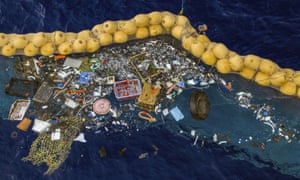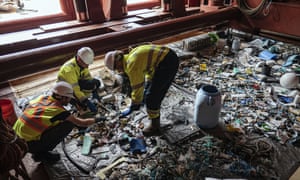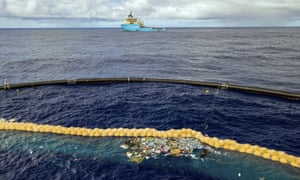https://www.theguardian.com/environment/2019/oct/03/ocean-cleanup-device-successfully-collects-plastic-for-first-time
Ocean cleanup device successfully collects plastic for first time
Floating boom finally retains debris from the Great Pacific Garbage Patch, creator says
A huge floating device designed by Dutch scientists to clean up an island of rubbish in the Pacific Ocean that is three times the size of France has successfully picked up plastic from the high seas for the first time.
Boyan Slat, the creator of the Ocean Cleanup project, tweeted that the 600 metre-long (2,000ft) free-floating boom had captured and retained debris from what is known as the Great Pacific Garbage Patch.
Alongside a picture of the collected rubbish, which includes a car wheel, Slat wrote: “Our ocean cleanup system is now finally catching plastic, from one-ton ghost nets to tiny microplastics! Also, anyone missing a wheel?”
About 600,000 to 800,000 metric tonnes of fishing gear is abandoned or lost at sea each year. Another 8m tonnes of plastic waste flows in from beaches.
Ocean currents have brought a vast patch of such detritus together halfway between Hawaii and California, where it is kept in rough formation by an ocean gyre, a whirlpool of currents. It is the largest accumulation of plastic in the world’s oceans.
The vast cleaning system is designed to not only collect discarded fishing nets and large visible plastic objects, but also microplastics.
The plastic barrier floating on the surface of the sea has a three metre-deep (10ft) screen below it, which is intended to trap some of the 1.8tn pieces of plastic without disturbing the marine life below.
The device is fitted with transmitters and sensors so it can communicate its position via satellites to a vessel that will collect the gathered rubbish every few months.
Slat told a press conference in Rotterdam that the problem he was seeking to solve was the vast expense that would come with using a trawler to collect plastics.
He said: “We are now catching plastics … After beginning this journey seven years ago, this first year of testing in the unforgivable environment of the high seas strongly indicates that our vision is attainable and that the beginning of our mission to rid the ocean of plastic garbage, which has accumulated for decades, is within our sights.
“We now have a self-contained system in the Great Pacific Garbage Patch that is using the natural forces of the ocean to passively catch and concentrate plastics … This now gives us sufficient confidence in the general concept to keep going on this project.”
The plastic gathered so far will be brought to shore in December for recycling. The project believes there may be a premium market for items that have been made using plastic reclaimed from the ocean.
“I think in a few years’ time when we have the full-scale fleet out there, I think it should be possible to cover the operational cost of the cleanup operation using the plastic harvested,” Slat said.
The plan is to now scale up the device and make it more durable so it can retain plastic for up to a year or possibly longer before collection is necessary.
During a previous four-month trial the boom broke apart and no plastic was collected. Since then, changes have been made to the design including the addition of a “parachute anchor” to slow down the device’s movement in the ocean, allowing for faster-moving plastic debris to float into the system.
The latest trial began in June when the system was launched into the sea from Vancouver. The project was started in 2013 and its design has undergone several major revisions. It is hoped the final design will be able to clean up half of the debris in the Great Pacific Garbage Patch.
• This article was amended on 4 October 2019 to clarify system location details.



沒有留言:
張貼留言